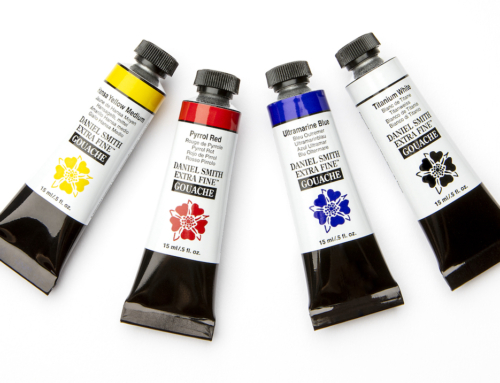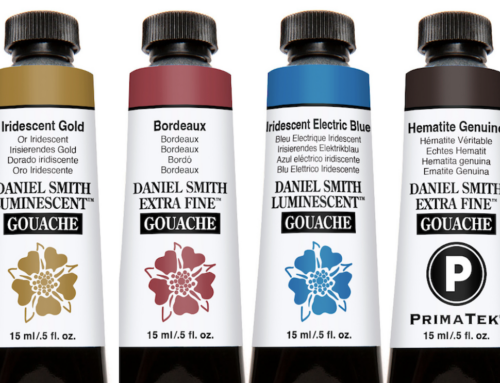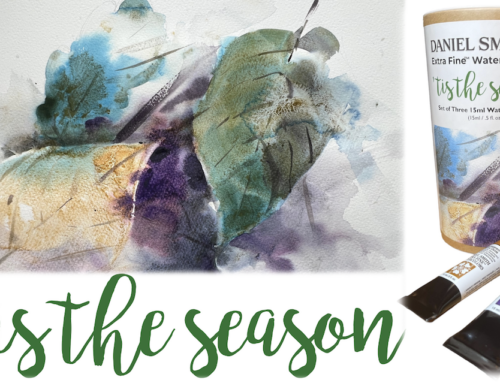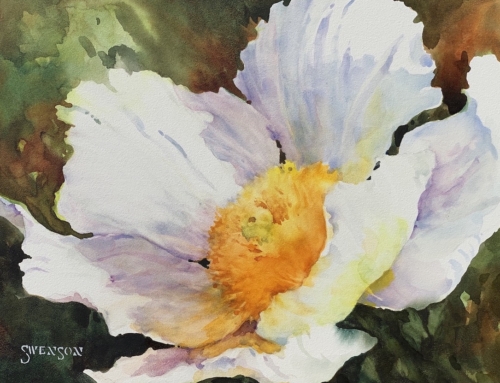Share:
“DANIEL SMITH Watercolors are the perfect vehicle for me to produce work with vivid color and fantastic greys. I trust these paints to provide a matte surface that allows beautiful, velvety darks and sharp, contrasting colors that are perfect for my brand of realism, time after time. They are my choice because they’re strong, consistent, vibrant and most importantly, predictable.”
Angus McEwan is known for pushing the limits of what can be done with watercolor. He applies colors thickly and enjoys the optics of mixing layers to create richly transparent art. He even creates his own tints with white to complement his palette.
Since he uses an extremely wide scale of colors in his work, choosing just 10 colors for this set was very difficult. He decided on colors that feature both warm and cool effects, along with favorites that are regularly on his palette. DANIEL SMITH Cobalt Blue is always on center stage in his work. He also loves Cobalt Teal Blue, Prussian Blue, Manganese Blue Hue and the full Quinacridone line, with Burnt Orange being a personal favorite.
Angus McEwan’s Master Artist Set includes:
- Van Dyck Brown
- Burnt Umber
- Prussian Blue
- Cobalt Blue
- Manganese Blue Hue
- Lavender
- Cobalt Teal Blue
- Indian Yellow
- Organic Vermilion
- Quinacridone Burnt Orange
Angus invites you to experiment with colors and layers. Try something new and unexpected; don’t be afraid to mix different colors. He recommends blending the Lavender and Burnt Orange to watch how the colors work together. It’s so satisfying to see what can develop with experimentation!
The perfect hunt for a subject
Hunter, explorer and light observer are words to describe Angus and his secrets for success in watercolor. He describes finding his subject as the perfect hunt – exploration with a different mindset that is focused on being alive to seeing. Light is always the main subject in his work – the right light looks like art in itself. Light paints everything, so the actual subject matter doesn’t really matter. We see something because of light. Cattle are most interesting in the chilly mist and good light on a person’s face explains their character. Light is truly always the subject.
Often his subject matter is a hidden gem needing to be discovered in a competitive landscape of the more obvious choices for beauty, such as a Venice canal that he may walk past to find such a treasure. He often examines and reexamines an area to watch the light play across it at different times of the day. Angus developed this critical eye towards light earlier in his theater career as a Chief Stage Director, designing everything on stage from makeup to costumes and set, all of which were powerfully impacted by light. He also has experience working on films with the same eye. As a college art educator for 24 years, he worked with many mediums, but always came back to watercolor.
Angus enjoys traveling whenever he can to hunt for new ideas in the best light and spends plenty of follow-up time in the studio time to get the outcomes he envisions. He sometimes adds something of his own to the original scene to take his vision to a deeper, more inspired level, making it beyond real.
Advice for the new painter
“Don’t be afraid of mistakes. You want some in your paintings. Mistakes are the learning part; it’s how you move forward. I have built on all the mistakes I have made.”
His theory on making mistakes goes back to 1996, when he won scholarship money that required him to pick a country to visit for three months to create 50 paintings for an Edinburgh exhibition. He chose China and describes his time there as a turning point in his art career. He was having problems at the beginning with finding his artistic stride while there. In a moment of discouragement, he angrily covered a painting all in white. As it dried, an interesting new image came through from beneath the white that he was inspired to rework. It was his a-ha moment when he realized that he could do much more than he thought he could. He had been trying to paint like other artists, which wasn’t working. He pushed through to discover that by giving himself more flexibility to create, he could find even more ways to create a multi-layered painting than just basic washes. After this humble beginning in China, he went on to win a Bronze award at the 2013 Shenzhen International Watercolor competition, where he has made lifelong friends.









